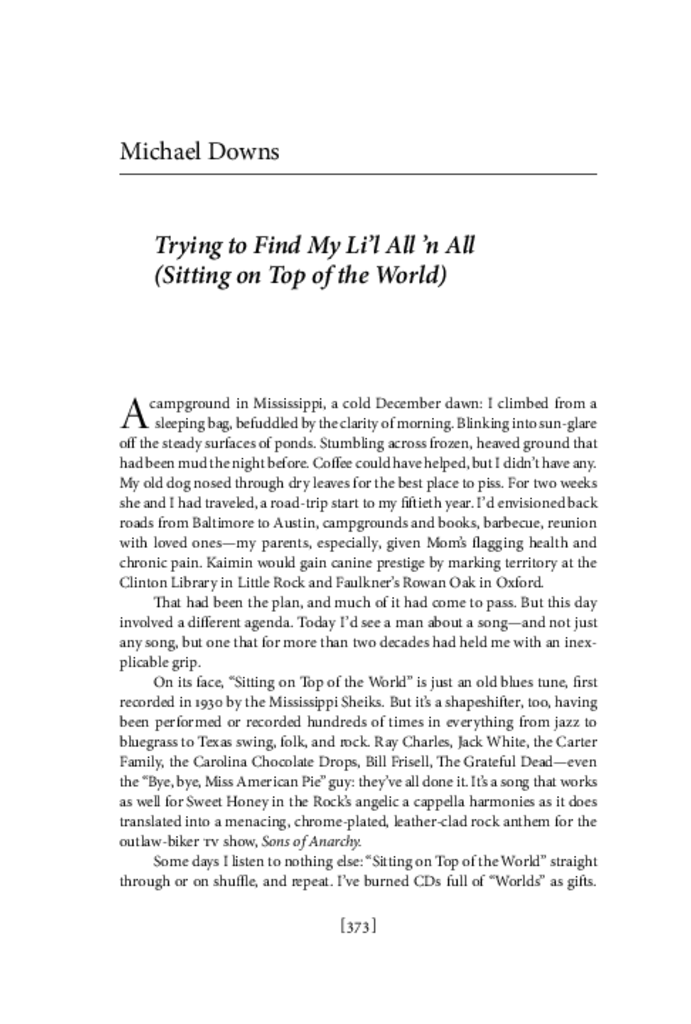Trying to Find My Li'l All 'n All
Lonnie Chatmon, fiddler for the Mississippi Sheiks listened to his partner, Walter Vinson, warble a tune Vinson had written the night before. It was 1929, and this was Mississippi, and the Sheiks were among the most popular Southern string bands. “Now she’s gone,” Walter sang, “I don’t worry. / I’m sitting on top of the world.”
“What kind of song is that?” Chatmon asked.
How Walter answered is lost to history. I like to think he shrugged, his only answer. Or maybe he said, “That’s a money-making song,” because when he played it on a street corner, passersby rang his bucket with seventeen dollars in coin.
“Sitting on Top of the World” has outlived its maker to be recorded hundreds of times as a blues or rock song, in gospel, bluegrass, jazz, folk, and Texas swing. Vital in so many genres, it belongs to none. “What kind of song is that?” remains difficult to answer, perhaps impossible – even as I listen to forty-plus versions while writing this narrative. Each version offers a different response: I’m hearing melancholy, ecstasy, lamentation, befuddlement, sassiness. Each performer works to understand what to feel – or what not to feel – now that she’s gone. How can one song contain such nuance, such variety? How does the human heart?
Trying to Find My Li’l All ‘n All a is a book-project that builds on a literary essay I wrote and which The Georgia Review published in Summer 2017. That essay encompasses much: Walter Vinson’s descendants, musicians who have recorded “World,” a road trip through the American South, and moments that reflect the song’s paradoxical nature. As art responding to art, it tries to answer Chatmon’s question. But the essay is only a beginning. The song – tied to the inexplicable, mutable nature of human happiness and sorrow – compels me now to consider other essential questions at the song’s core. In its paradoxes I hear my mother, who during a decade of chronic pain learned to turn cheerful songs into a bitterness. I hear the methamphetamine addict who knifed to death his drug-dealing partner, then screamed, “I’m sitting on top of the world!” The song gives me to wonder about what philosophers call “the science of happiness” and to ask why there is no equivalent “science of sorrow.” These questions echo ones I’ve explored before, including in my forthcoming novel, The Strange and True Tale of Horace Wells, Surgeon Dentist, which reimagines the life of the 19th-century dentist who discovered anesthesia but who died an addict.
“World” also drives me to better understand its silences. Who is the narrator, the constructed “I” who begins his story, “It was in the spring, one summer day”? What worried him but doesn’t now that she’s gone? Pregnancy? Adultery? When I listen to a version by Ellen McIlwaine, one of the few women to record the song, I hear a hint at murder. “Now he’s gone to stay,” Ellen sings. “Oh, yes. He’s gone.” Old ballads from the British Isles often revealed the sly confessions of murderers, and those ballads influenced the course of American Southern music.
So, “Sitting on Top of the World” is of mixed character, a hybrid, and so too this proposed project. What persona, what constructed “I”, will I use to explore the song’s mysteries? What varieties of literary writing will serve to reveal Vinson’s art? My proposal is work in memoir, song biography, micro and lyric essays – “World” pushing me to find a form, as Walter Vinson found a form, to contain so much that is inexpressible. What I make will be hybridized and new, but also like Vinson’s song it will come out of tradition: the ekphrastic tradition that uses literary art, rather than criticism, to expand and complicate the possibilities of another work of art.
Walter Vinson’s masterpiece has fascinated me for a quarter century. It’s a zen koan from the Mississippi Delta, circa the Great Depression – worth close attention and exploration. Through this project I’ll continue to delve into its mysteries through music theory, psychology, ethnography, history, and through the poetry of the song’s lyrics. I’ll follow its great reach into my own family history, the American South, and ultimately the reasons why the song, with its ironies and its honesty, won’t let me go.





